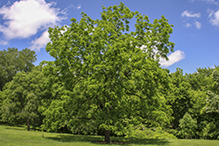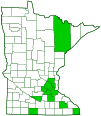Amur corktree
(Phellodendron amurense)
Conservation • Weed • Description • Habitat • Ecology • Use • Distribution • Taxonomy
Description |
||
Amur corktree is a moderate- to fast-growing, The trunk is short and divided low into several large branches. The crown is broad and often flat topped. The bark on young trees is light golden brown or yellowish-gray. On mature trees the bark is gray, thick, deeply furrowed, and slightly spongy or corky. Inner bark is bright yellow. First year twigs are light green to green, hairless, slender, and round in cross section. They have white pith. Second-year twigs are brown, smooth, slender, and shiny, with scattered pale, raised dots (lenticels). Third-year twigs are slender and dull brown. They have tan pith. The leaf scars are large, raised, and U-shaped, almost encircling the bud. They have 3 groups of small bundle scars. The bud is concealed by the leaf stalk (petiole) until the leaf drops. It is brown, naked, broadly rounded, and covered by 2 brown, fuzzy, immature, scale-like leaves. The leaves are deciduous, opposite, The leaflets are lance egg-shaped to egg lance-shaped, Male and female flowers are borne on separate trees. They appear from May to June. The inflorescence is a loose, open and spreading, Each flower is about ⅛″ in diameter and is borne on a slender stem (pedicel). There are 5 sepals and 5 petals. The sepals are green or maroon, united at the base, and separated into 5 teeth at the tip. The petals are yellowish-green, united at the base, and separated into 5 lobes. Male flowers have 5 stamens with white filaments and bright yellow anthers protruding well beyond the petals. Female flowers have a pistil and 5 rudimentary staminodes that do not project beyond the petals. The infructescence is loose, open, and spreading. Each fruit is a ¼″ to ½″ in diameter berry-like drupe with 5 seeds. It ripens from mid-June to mid-July. It is green at first, turning black when mature. The fruits remain on the tree until early winter. |
||
Height |
||
30″ to 45″ |
||
Record |
||
There is no Minnesota state champion of non-native trees. |
||
Flower Color |
||
Yellowish-green |
||
Similar Species |
||
| Chinese corktree (Phellodendron chinense) branches, pedicels, and rachis are robust. The leaflets are broader, up to 2⅜″. The inflorescence and infructescence are compact. It has been reported only in Winona County. | ||
Habitat |
||
Moist but well-drained. Full to partial sun, but saplings are highly shade tolerant. Rich soil. |
||
Ecology |
||
Flowering |
||
May to June |
||
Pests and Diseases |
||
None |
||
Use |
||
|
||
Distribution |
||||
|
Sources |
|||
| 2/16/2023 | ||||
Nativity |
||||
Native to eastern Asia. Cultivated in Europe and Australia. Introduced in North America around 1856. Naturalized. |
||||
Occurrence |
||||
Adventive. Rare in Minnesota. |
||||
Taxonomy |
|||
| Kingdom | Plantae (Plants) | ||
| Division | Tracheophyta (Vascular Plants) | ||
| Subdivision | Spermatophytina (Seed Plants) | ||
| Class | Magnoliopsida (Dicots) | ||
Order |
Sapindales (soapberries, cashews, mahoganies, and allies) | ||
Family |
Rutaceae (citrus) | ||
| Subfamily | Zanthoxyloideae | ||
Genus |
Phellodendron (corktrees) | ||
Subordinate Taxa |
|||
|
|||
Synonyms |
|||
Phellodendron japonicum Phellodendron lavallei Phellodendron sachalinense |
|||
Common Names |
|||
Amur corktree Chinese corktree |
|||
Glossary
Bundle scar
Tiny raised area within a leaf scar, formed from the broken end of a vascular bundle.
Drupe
A fleshy fruit with usually a single hard, stone-like core, like a cherry or peach; a stone fruit.
Filament
On plants: The thread-like stalk of a stamen which supports the anther. On Lepidoptera: One of a pair of long, thin, fleshy extensions extending from the thorax, and sometimes also from the abdomen, of a caterpillar.
Lenticel
A corky, round or stripe-like, usually raised, pore-like opening in bark that allows for gas exchange.
Pedicel
On plants: the stalk of a single flower in a cluster of flowers. On insects: the second segment of the antennae. On Hymenoptera and Araneae: the narrow stalk connecting the thorax to the abdomen: the preferred term is petiole.
Petiole
On plants: The stalk of a leaf blade or a compound leaf that attaches it to the stem. On ants and wasps: The constricted first one or two segments of the rear part of the body.
Rachis
The main axis of a compound leaf, appearing as an extension of the leaf stalk; the main axis of an inflorescence.
Sepal
An outer floral leaf, usually green but sometimes colored, at the base of a flower.
Staminode
A modified stamen that produces no pollen. It often has no anther. Plural: staminodia.
Visitor Photos |
|||||
Share your photo of this plant. |
|||||
| This button not working for you? Simply email us at info@MinnesotaSeasons.com. Attach one or more photos and, if you like, a caption. |
|||||
|
|||||
MinnesotaSeasons.com Photos |
|||||
Tree |
|||||
 |
 |
||||
 |
 |
||||
Furrowed Bark |
|||||
 |
 |
||||
 |
|||||
Rough Bark |
|||||
 |
 |
||||
 |
 |
||||
Leaves |
|||||
 |
|||||
Infructescence |
|||||
 |
 |
||||
 |
|||||

Visitor Videos |
|||
Share your video of this plant. |
|||
| This button not working for you? Simply email us at info@MinnesotaSeasons.com. Attach a video, a YouTube link, or a cloud storage link. |
|||
Other Videos |
|||
| How to ID Phellodendron amurense Laura Deeter |
|||
About
Uploaded on Nov 19, 2008 Short video with the top identifying characteristics for Phellodendron amurense |
|||
| Chinese Herbs in America: Phellodendron - Clearpath SHM Clearpath School of Herbal Medicine |
|||
About
Published on Apr 21, 2014 Wildcrafting Amur Cork Tree (Phellodendron amurense) in Northwest Connecticut. An under utilized Chinese herbal medicine now considered an invasive species in many parts of the U.S. This video focuses on properly identifying the tree in the wild among several lookalikes,and talks about the medicinal uses of the bright yellow inner bark. |
|||
| Eric Morgan Poster 2 - Botany 2010 Botany Conference |
|||
About
Uploaded on Aug 11, 2010 Determining the Invasive Capabilities of the Exotic Tree Phellodendron amurense Rupr. in Northeastern North America. Co-author: Jonathan Borysiewicz Study of an introduced exotic tree species Phellodendron amurense Rupr. which has been used as an ornamental tree over the past century throughout areas of the Northeastern United States. Current research initiatives involve documenting and analyzing invasions of the tree into urban and suburban woodlands. Five study sites were chosen after careful survey of the pertinent literature, records of established northeastern herbariums, and responses from a 2008 request sent to botanical organizations and universities. Sites include data from 2 counties in Connecticut, 2 counties in New York, and 1 county in Pennsylvania. Field studies were conducted at each of the five sites using a variation of the Point-Center-Quarter method to determine the importance value of P. amurense within the forest. The results of this experiment indicate that P. amurense can invade multiple forest types and densities. The implications of this provide strong evidence for more research on the invasive abilities of P. amurense, strict management policies in areas that are already invaded, and nomination of P. amurense for listing in invasive plant databases (e.g. IPANE). |
|||

Visitor Sightings |
|||||
Report a sighting of this plant. |
|||||
| This button not working for you? Simply email us at info@MinnesotaSeasons.com. Be sure to include a location. |
|||||
|
|||||
MinnesotaSeasons.com Sightings |
|||||

Last Updated:


